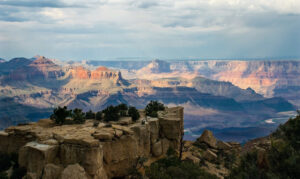In the last issue of the Happ-O-getics I began this as a four-part series. The first evidence (the central truth) is that the inspired Word of God teaches it. The second is: A global flood is supported by the evidence in the fossils.
In my doctoral work in biology, the fossil record was the showcase of science. Today, fossil evidence has been preempted by creationists and proponents of a global flood. Why?
The discovery of massive fossil graveyards around the world

Billions of nautiloids, corals, clams, sea lilies, snails, and other marine organisms are fossilized in a seven-foot-thick layer within the Redwall Limestone of Grand Canyon. This graveyard stretches for 180 miles across northern Arizona and into southern Nevada, covering an area of at least 10,500 square miles. It is estimated that it would take twenty-four cubic miles of lime sand and silt, flowing in a thick, soup-like slurry at more than eleven miles-per-hour to catastrophically overwhelm and bury this huge, living population. Another such graveyard in France has hundreds of thousands of both marine and terrestrial creatures buried together on the continent.
The discovery of marine fossils high on mountains
Marine fauna had to first be buried in sedimentary layers on land. When the layers buckled at the end of the flood, the marine fossils in them were uplifted even to the heights of the Himalayas in Nepal. To find marine fossils in layers on top of most mountains and at 2,950 feet above sea level in most layers of the Grand Canyon, marine creatures had to be swept over the continents, buried in layers there, and then lifted when the mountains formed.
The discovery of exquisitely preserved fossils
Thousands of delicate jellyfish were found impeccably preserved in sandstone covering more than 400 square miles in the South Australian outback. Researchers concluded this could not happen slowly over time, but they had to be buried very quickly. A marine reptile about six-feet long was fossilized at the moment of giving birth. Some squids have been found with ink still in their ink sacs. Fish were buried and fossilized so quickly that fine details of their fins and eyes can still be studied today.
Conclusion: Only a catastrophic global flood can adequately explain these discoveries.



